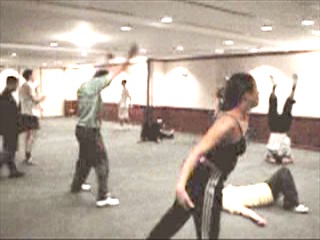AH-HA MOMENTS IN OUR KUNGFU SYLLABUS

Chi flow in Shaolin Kungfu can be very vigorous
Question
Sifu has continually improved and evolved his teaching methodology over the years so that students, both old and new, continually accumulate more and more benefits. What are some of the ah-ha moments that Sifu had that led to the formation of our Shaolin Wahnam Kung Fu syllabus as it is today? Will our syllabus continue to change and evolve in the future as Sifu improves his teaching methodology?
-- Sifu Lee Wei Joo
Answer
Since teaching kungfu and chi kung at least 30 years ago, I have improved my teaching methodology tremendously, often beyond recognition. I have often said that teaching kungfu and chi kung is an excellent way to improve ones performance of kungfu and chi kung, and I am a shining example.
I have many advantages that other masters may not have. I teach more than a hundred courses a year, whereas most masters have the same class following them every year. A course of a few hours or even a few days is different from a regular class of unlimited duration, but what I learned in my teaching, I applied quite immediately in the next course.
I also have the advantage of being childlike, of viewing any new situation with awe, whereas many masters regard their jobs as routine, sometimes they are quite bored with what they have to do every day.
Like many instructors in our school, I am also generous. This is closely linked to the policy of our school. If we wish to preserve and promote the greatness of kungfu and chi kung, we have to share secrets. Our training also make us very generous.
There were many ah-ha moments in the formation of our Shaolin Wahnam kungfu syllabus today, which for our convenience may be divided into our Shaolin syllabus and our Taijiquan syllabus. There were also ah-ha moments in our chi kung syllabus. It is worthy to note that our kungfu is also chi kung and meditation, but some of these ah-ha moments were discovered in chi kung classes where our students did not learn kungfu.
Many of these ah-ha moments have become so common-place that they are no longer ah-ha moments now, though they might be in the past. Some of the teaching methods developed over time. So they might not be ah-ha moments, though they are very significant.
I have often mentioned that our typical students now can attain in one month the wonderful benefits that I would take a year to attain when I was a student – at a time when I was already known as a kungfu genius. Others many not believe it; but that is their problem. Hence we have to guard against over-training.
One of the ah-ha moments to many new students, though it might not be so to me or our instructors as it has become common-place, is chi flow. It took me more that 20 years to have a chi flow consciously. Our student at the most would take a month; those who attend my intensive or regional courses would take less than half an hour! Chi flow is very significant because all chi kung benefits come from chi flow, and our kungfu is also chi kung.
Another very significant ah-ha moment, though many students may not realize it, is that our kungfu as well as our chi kung are triple cultivation, i.e. cultivation of the physical, energy and spirit, or “jing”, “qi” and “shen” in Chinese. This is very high level kungfu and chi kung. Much of kungfu and chi kung today is only physical. Most of what others practice as kungfu or chi kung are actually not kungfu or chi kung; they merely perform kungfu forms or generously exchange blows, and they only practice gentle physical exercise.
Many students had their ah-ha moments when they overcame their diseases, especially so-called incurable diseases. This was a main reason why I taught chi kung to the public.
More students, who were already healthy, found joy in their daily living. This was more obvious. What might not be so obvious was that they attained peak performance. They usually practice kungfu.
These ah-ha moments, which might not happen instantly but spread over a period of time, are directly related to the formation of our kungfu syllabus. When I wrote our kungfu syllabus, I was keenly aware that practicing kungfu in our law-abiding societies will bring us peak performance and spiritual joys.
Let us now look at the “Becoming a Shaolin Wahnam Kungfu Practitioner” course for which your question is particularly related. At the course, amongst other things, I shall teach how to capture an opponent’s weapon, and how to fight against multiple opponents who are unarmed and armed.
These are very advanced topics, not normally taught in most other kungfu schools. If they are ever taught, they are taught in secret to specially selected disciples who have won the master’s trust. This may provide some ah-ha moments to many students.
Our syllabus has become so advanced today that we need to guard against over-training. I may continue to improve our teaching methodology and share the secrets with our students.
The questions and answers are reproduced from the thread 10 Questions on "Becoming a Shaolin Wahnam Kungfu Practitioner" in the Shaolin Wahnam Discussion Forum.
LINKS
